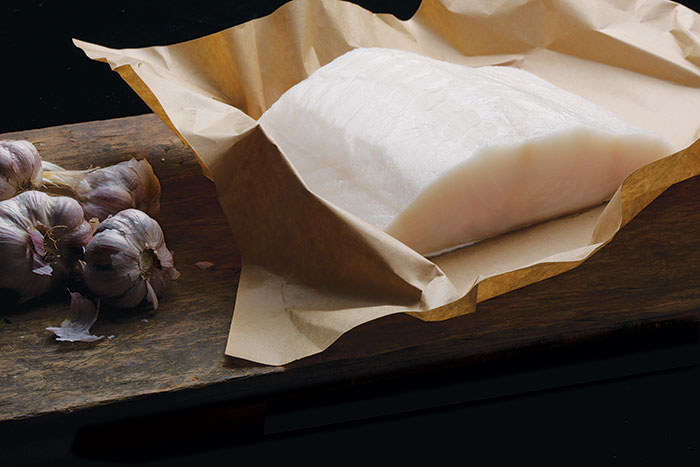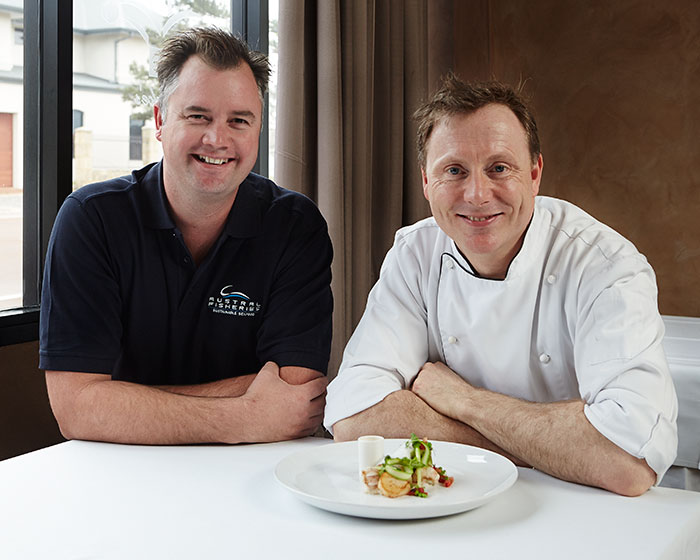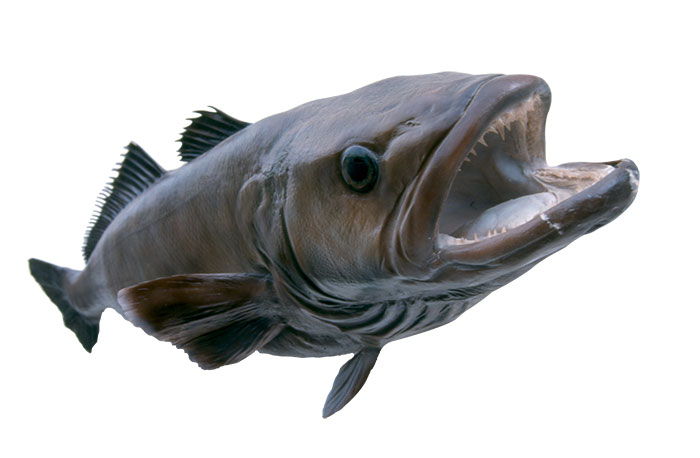Only a few years since illegal fishing nearly wiped them off the menu, internationally sustainable fisheries are putting toothfish back on our plates.
Only a few short years since illegal fishing nearly wiped them off the menu for good, new internationally sustainable fisheries are putting the Southern Ocean toothfish, beloved of chefs and diners alike, back on our plates.
Everything about Australia's newly branded Glacier 51 Toothfish is extreme: its looks, its size (the fish can reach 2m in length), its environment. Even the story of its journey from pirate plunder to species under threat to Marine Stewardship Council (MSC) certification is outlandish. But while it's highly prized in America and Japan – its fillet renders large, luscious, arctic-white flakes that unfold like petals on a plate and taste sublime – most Australians have yet to taste it.
Toothfish shot to prominence in the 1990s when Chile started selling it into the American market (it's still known as Chilean seabass in the US). While legal fisheries were developed and flourished, their success led to an influx of pirates to the sub-Antarctic, poachers who plundered the fisheries for their 'white gold'.
It was just at this time that Austral Fisheries took up an Australian Government initiative to develop new fisheries. Austral's CEO, David Carter, remembers well the company's first expedition in 1994. "We went to Macquarie Island, south-east of Tasmania. We thought we would find orange roughy, but came back with this weird-looking black fish instead." It was identified, on their return, as Patagonian Toothfish.
.jpg)
Fishing crews must often brave grim conditions in search of the feted fish.
The company then decided to explore the area around Heard Island. While the first attempt to locate fish was unsuccessful, on the second try, Austral found what became known as the Glacier 51 Toothfish, named after a large glacier on the island.
Situated in the Southern Ocean in Australian Antarctic Territory, Heard Island is more than 4000km south-west of Perth. Surrounded by glaciers, it is home to Australia's only active volcano, Big Ben, and endures winds of up to 95 knots. On Heard Island, the snow falls horizontally, it rains 75 per cent of the time, and the swell often reaches over 10 metres.
As well as discovering toothfish in this inimical environment, the Austral expedition stumbled on more besides: six Argentinian vessels illegally fishing in Australian waters.
"Our crew were the first Australians to discover illegal fishing in the area," says David. "In the beginning, we were fighting real pirates – they were opportunistic, largely South American boats, unarmed and easy to discourage with a navy patrol." This changed when Australian authorities caught a boat and uncovered a very sophisticated operation run by Asian crime syndicates. "These vessels were purpose-built and equipped with radar to help avoid detection."
By the early 2000s, the illegal, unreported and unregulated (IUU) fishing, combined with the legal catch, had brought the toothfish fisheries in the Southern Ocean to the brink of collapse. The years after took David and the company – then known as Kailis and France, and led by the late Theo Kailis and Murray France – on a dramatic ride, fighting not only the pirates, but also to convince the governments of Australia and other countries to acknowledge the seriousness of the illegal fishing.
To man the frontline, they helped to establish COLTO – the Coalition of Legal Toothfish Operators – and started a massive awareness campaign. The company even hired private investigators to track down pirate vessel owners in rogue countries, paying out more than $100,000 in rewards for information. Forming close relationships with conservation groups to create a united front, they embarked on a range of preventative measures, including a submission to the French Cabinet to have a patrol aircraft based in their territory (it was declined), and seeking legal opinion on the possibilities of crew on Australian boats making citizen's arrests, and of arming civilian vessels.

The robust vessel used to catch the prized specimens.
The issue came to prominence in September 2002, when Chris Masters filed a story for the ABC's Four Corners program, investigating illegal fishing and its links to organised crime. Then, in August 2003, came the famous three-week chase and capture by an Australian customs boat of the Uruguayan vessel Viarsa. The vessel was caught laden with 85 tonnes of toothfish, with a value of more than $1 million, and the events went on to inspire a book by Wall Street journalist G. Bruce Knecht, Hooked: Pirates, Poaching and the Perfect Fish.
"Things suddenly got dinkum," says David "It was headline news and the government of the day took courageous action."
Australia dramatically increased its patrols and signed a Memorandum of Understanding (MOU) with the French Government to coordinate surveillance, which continues today. Action was also taken by Commission for the Conservation of Antarctic Marine Living Recourses (CCAMLR) to introducing a suite of monitoring and compliance tools: a satellite Vessel Monitoring System (VMS), through which vessels report in every four hours; a vessel 'black list' to assist port authorities in identifying non-compliant vessels; and a sophisticated Catch Documentation Scheme that tracks the haul from the time it leaves the water to the time it arrives at market, providing an electronically verifiable trail for each step of the way.
with-fellow-crewman-on-board-vessel-at-Heard-Island)-SDC10182.jpg)
Crew members hanging their catch.
Since 2005, no illegal foreign fishing vessels have been detected inside Australia's Exclusive Economic Zones. Evidence exists, however, from a variety of sources (including licensed operators, VMS and aerial surveillance) of at least seven vessels operating illegally in the high seas area managed by CCAMLR.
"Our measures have been effective, but we still need to remain vigilant," says Andrew Wright, Executive Secretary of the Hobart based CCAMLR Secretariat. Indeed, in April, Malaysian authorities detained two vessels, which are being investigated for unloading illegal catch and IUU fishing. It is suspected that they are part of the seven illegal vessels known to be operating, and – because of the high number of crew on board – that a third boat may have sunk and the crew rescued by the captured boats.
Worldwide, there are 13 licensed toothfish fisheries. Six have gained independent Marine Stewardship Council (MSC) certification as sustainable well-managed fisheries: Australia's two fisheries at the Heard Island and McDonald Islands (HIMI) and Macquarie Island, along with Kerguelen Islands (France), South Georgia (UK), Ross Sea (New Zealand) and Falkland Islands (UK). Combined, they equate to 56 per cent of the world's toothfish catch being MSC-certified. The Argentine fishery currently under MSC assessment will account for a further 16 per cent of the total catch.
"MSC certification clearly confirms the transformation of the toothfish fishery," said MSC manager Australia and New Zealand, Pat Caleo. "Everyone should celebrate that and enjoy eating MSC-certified toothfish. It's a great example of what can be achieved when fishers, fishery managers, researchers and conservation groups work together."

The pearly flesh of a toothfish fillet.
Last year, Australia's two toothfish fisheries were upgraded to 'Best Choice' level on America's acclaimed Monterey Bay Aquarium's Seafood Watch program.
"Getting our toothfish upgraded from 'Avoid' to 'Best Choice' on the influential Seafood Watch program was very important to us," says Dylan Skinns, Austral's sales and marketing manager. "Gaining MSC certification was an important step to
achieving this big leap".
In addition, the Australian online seafood guide GoodFishBadFish says that it is reviewing its toothfish rating, while The Australian Marine Conservation's Sustainable Seafood Guide lists toothfish as a 'better' choice. Greenpeace's international Red List bans Chilean seabass, however, and lists trawling (the majority of Australian toothfish is caught by longline) and the life cycle of the fish as primary reasons behind the decision. The list also bans all wild and farmed prawns, and farmed Atlantic salmon.
"We now have a good toothfish story to tell," says Dylan, "so we thought it was
time to test out the local market, create a value-added product under the brand Glacier 51 Toothfish, and take it to Australian chefs to see how they like it.
"We singled out 40 chefs around Australia, went to see them with the product, and asked, 'How would you like it? What format? What size, what cut, what's best for you?'"
The verdict was two matching 8-10kg fillets, skin on, bone in, so each chef could cut the fillet exactly how he or she prefers.
"The response has been great, and now we are about to launch a frozen retail pack," Dylan says. "The wonderful thing about toothfish is that it is almost impossible to overcook because of its high fat content. It will retail for around $60 a kilo."
For Austral CEO David Carter, who was named 2013 Seafood Industry Icon of the Year at the Australian Seafood Industry Awards, his journey with the toothfish to this point has been a rollercoaster ride. "Right now, it feels kind of nice," said David, "But I never get excited, my job is one of eternal vigilance. And eventually we reckon there is a book to be written – it's a ripping yarn, and a fascinating case study of cooperation between fishery conservation and best-practice fishery management."
For more information about toothfish, visit afma.gov.au, ccamlr.org or msc.org.

Stephen Clarke and Dylan Skinns, from Austral Fisheries, with Stephen's signature toothfish dish.
Something to get your teeth into
Stephen Clarke of Clarke's of North Beach, winner of awards including 2012 Good Food Guide Chef of the Year, WA Chef of the Year (three times), and 2012 Australian Culinary Federation Chef of the Year, has Glacier 51 Toothfish permanently on his menu.
"It's a quality fish," he says. "It's expensive, but people don't come to Clarke's for a chicken breast. They want to try something different, they want to be adventurous – that's our niche.
"I serve a small portion sautéed – so that people get to taste the fish exactly as it is – but of course, anyone can do this. Then we do something 'chefy'. I make a mousseline using prawn and scallop, wrap it in a strip of Glacier 51 Toothfish, put it in the fridge for a short time so it starts to tighten, then it goes into sous vide at 62 degrees – this is like giving it a warm bath, and it relaxes. Then it is rolled in herb and brioche crumb, and served with an Exmouth tiger prawn and Esperance scallop, and comes with a bisque sauce.
"I like knowing the story behind the toothfish," he says. "I want to do justice to all the food I present."

How the toothfish fishery is managed
Being responsible for the conservation of Antarctic marine ecosystems, the Commission for the Conservation of Antarctic Marine Living Resources practises an ecosystem-based management approach. This does not exclude harvesting, if it is carried out in a sustainable manner and takes account of the effects of fishing on other components of the ecosystem. Management measures for fishing in this World Heritage-listed area include:
-
A strict limit on the number of vessels licensed to operate in the toothfish fisheries
-
A Total Allowable Catch (TAC) set for both toothfish and non-target species
-
Placement of two government-approved observers monitoring all aspects of fishing operations on board Australian toothfish vessels on every voyage
-
The HIMI Marine Reserve was declared in 2002. It is closed to fishing and is one of the largest marine reserves in the world
-
No fishing without having a bird-scaring line trailing out the back of the boat to keep birds away from the hooks, and well as a bird-scaring device while hauling the line
-
Seasonal closures to ensure no fishing during periods when seabirds are known to be feeding their chicks
-
Boats must use weighted longlines so that the baits and hooks sink before birds can grab them
-
All offal must be retained on board. Nothing apart from fishing gear and bait goes overboard when inside the fishery (to avoid attracting seabirds when they may otherwise be vulnerable to the baits and hooks).